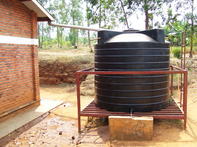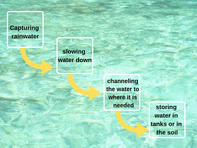Poor soil conservation practices and deforestation lead to massive soil erosion and land degradation. Add to this a drought’s devastating effects on available groundwater and the results are unproductive farms, farmers abandoning their farms, decreased food production and poverty.

Rainwater harvesting has supported early civilisations for some 3000 years ago. Today, rainwater harvesting is a sustainable practice used by both small producers and commercial farmers. In addition, water conservation is essential to ensure water for future use and adequate resources for the expansion of farming.
What is Rainwater Harvesting?

Rainwater harvesting is when rainwater is collected to be used for farming or household use. Methods of rainwater harvesting include diverting, collecting and storing runoff water. Water can be collected from natural drainage lines such as contours and streams, from ground surfaces and buildings' roofs.
Rainwater can then be stored in buckets, tanks or dams. Often rainwater is harvested into shallow dams where it is used for irrigation but also allowed to soak into the soil to recharge groundwater. Groundwater supplies springs and boreholes.
What is Water Conservation?
Water conservation is the protection, development and efficient management of water. In irrigation, water conservation demands that as much water as possible must infiltrate the soil to minimise evaporation and water runoff.
Examples of water conservation include the following: Recycle water and re-use water - such as using washing water to water vegetables. Irrigate crops in sensible ways - watering less often but more thoroughly and not watering during the heat of the day.
Fix leaking taps and pipes. Grow indigenous plants and crops suitable to the local climate and environment.
Soil Conservation and Water Conservation
What is the link between soil and water? Soil is the biggest reservoir of water and good soil structure will help with the effective storage of water. The rate of absorption of water into the soil depends on factors such as the soil type, if a crop is planted in the soil, the soil structure and the slope of the soil
When water is stored in the soil, the roots of crops will be able to access this reservoir of water. Therefore, soil conservation is important to retain a fertile base to planted crops as well as to provide a water reservoir for the plants. This can be done by covering the soil with a mulch such as a crop residue.
This increases water infiltration and lowers soil temperature, thereby reducing evaporation. More examples of soil conservation techniques include no-tillage or minimum tillage, basin tillage, using green manure and planting cover crops.
Basin tillage is the loosening of soil in a small basin or shallow dam created just in front of a ridge on a slope. Water collects in the basin during rainfall, which is absorbed easier when the soil is loosened.
Advantages of Rainwater Harvesting
Collecting rainwater has many advantages. When harvesting rainwater on a slope or hill, it can prevent soil erosion caused by water runoff after heavy rains. Rainwater harvesting structures are easy to build, do not require expensive materials and are low-maintenance.
Harvesting rainwater reduces time to collect water from water points and rivers and can help a household to become water-independent, especially when harvesting rainwater from a roof.
Source Water Research Commission